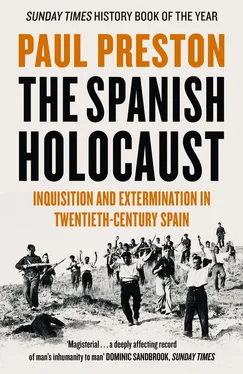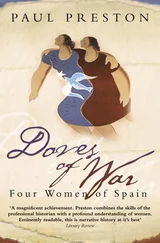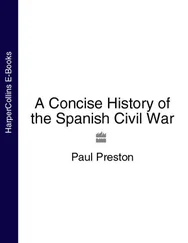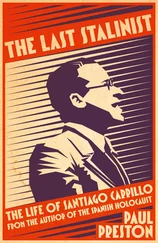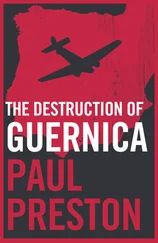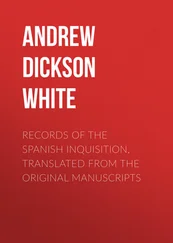The behaviour of the colonial units provoked serious friction between General López Ochoa, on the one hand, and Franco and Yagüe, on the other. The austere López Ochoa had been placed in operational command of the forces in Asturias. He believed, rightly, that for Franco (below him in seniority) to have been placed in overall charge of the suppression of the rebellions of 1934 was improper, since its only basis was his friendship with Diego Hidalgo. Franco, Yagüe and many on the right were concerned that López Ochoa, as a Republican and a Freemason, would try to put down the rising with as little bloodshed as possible. Their suspicions were justified. Although he condoned the use of trucks of prisoners as a cover for his advances, López Ochoa did, in the main, conduct his operations with moderation. Yagüe sent an emissary to Madrid to complain to both Franco and Gil Robles about his humanitarian treatment of the miners. All three were infuriated by López Ochoa’s pact with the miners’ leader Belarmino Tomás, holding back the Legionarios and Regulares to permit an orderly and bloodless surrender. 101Franco’s mistrust of López Ochoa was matched by his confidence in Yagüe and his approval for the summary executions following the captures of Gijón and Oviedo. 102
On one occasion, Yagüe threatened López Ochoa with a pistol. 103Some months later, López Ochoa spoke with Juan-Simeón Vidarte, the deputy secretary general of the PSOE, about his problems in restraining the murderous activities of the Foreign Legion:
One night, the legionarios took twenty-seven workers from the jail at Sama. They shot only three or four because, as the shots echoed in the mountains, they were afraid that guerrillas would appear. So, to avoid the danger, they acted even more cruelly, decapitating or hanging the prisoners. They cut off their feet, their hands, their ears, their tongues, even their genitals! A few days later, one of my most trusted officers told me that there were legionarios wearing wire necklaces from which dangled human ears from the victims of Carbayín. I immediately ordered their detention and execution. That was the basis of my conflict with Yagüe. I ordered him to take his men from the mining valleys and confine them in Oviedo. And I held him responsible for any deaths that might take place. To judge the rebels, there were the courts of justice. I also had to deal with the deeds of the Regulares of the tabor [battalion] from Ceuta: rapes, murders, looting. I ordered the execution of six Moors. It caused me problems. The Minister of War, all excited, demanded explanations: ‘How can you dare order anyone to be shot without a court martial?’ I answered: ‘I have subjected them to the same procedures to which they subjected their victims.’ 104
The events of October 1934 escalated the hostility between the left and the forces of order, particularly the Civil Guard and parts of the army. The Asturian rebels knew that, to control the mining valleys, they had to overcome the Civil Guard. Accordingly, they assaulted various local barracks to neutralize them prior to an attack on the capital city of the province, Oviedo. These episodes were violent and protracted. The bloodiest took place in Sama de Langreo, seventeen miles east of Oviedo, and in Campomanes, fifty miles to the south. In Sama, the battle raged for thirty-six hours and thirty-eight Civil Guards were killed. In the battle at Campomanes, twelve Civil Guards were killed and seven wounded. 105In total, the casualties of the Civil Guard in Asturias were eighty-six dead and seventy-seven wounded. The Assault Guards lost fifty-eight dead and fifty-four wounded. The army lost eighty-eight dead and 475 wounded. Other security forces lost twenty-four dead and thirty-three wounded. These figures may be compared with the nearly two thousand civilian dead, the large majority of them working class. 106
October 1934 saw only sporadic clashes elsewhere in Spain. However, there were casualties in Albacete, at both Villarobledo and Tarazona de la Mancha, during assaults on the town halls and other public buildings. In Villarobledo, four people were killed as order was restored by the Civil Guard, which suffered no casualties. In Tarazona, earlier in the summer, the Socialist Mayor had been removed from his post by the Civil Governor of Albacete, the Radical José Aparicio Albiñana. Now, his right-wing replacement was badly wounded in the struggle. Aparicio Albiñana responded to the situation by sending in reinforcements of the Civil Guard. One Civil Guard and several municipal policemen were killed during the defence of the town hall. The rest of the province was hardly affected by the revolutionary movement. 107
In the province of Zaragoza, the call for a general strike was ignored by the CNT and therefore a failure. However, there were bloody confrontations in Mallén, Ejea de los Caballeros, Tauste and Uncastillo in the area known as Las Cinco Villas, one of the parts of Aragon where social conflict was fiercest during the Republican years. It was a cereal-producing area of huge holdings, where a few landlords held many properties and the local day-labourers depended for survival on their access to common lands which had been enclosed by legal subterfuge in the nineteenth century. The bitterness of the election campaigns of November 1933 and the June harvest strike had contributed to the intensification of class hatred in the area and this was reflected in clashes on 5 and 6 October. 108In Mallén, one Civil Guard was killed and another wounded and a villager shot dead. In Ejea, a Civil Guard and a villager were wounded. In Tauste, a revolutionary committee took over the village and the Civil Guard barracks was attacked. The revolutionaries were crushed by a regiment of the army which fired on them with machine-guns and an artillery piece. Six villagers were killed. 109
The most violent events in Cinco Villas took place at Uncastillo, an isolated village of barely three thousand inhabitants. In the early hours of the morning of Friday 5 October, emissaries arrived from the UGT in Zaragoza with instructions for the revolutionary general strike. The mild-mannered Socialist Mayor of Uncastillo, Antonio Plano Aznárez, told them that it would be madness. He was no revolutionary, but rather an unusually cultivated man adept at navigating the complex bureaucratic mechanisms of the agrarian reform. He had earned the hatred of the local landowners by dint of his success in introducing equitable job-sharing, in establishing reasonable working conditions, in recovering some common lands that had been taken from the village by legal subterfuges in the previous century and in improving the local school. Now, however, contrary to his advice, the urgings of the men from Zaragoza were enthusiastically taken up by the local labourers, many of whom were unemployed and whose families were starving.
At 6.00 a.m., when the strikers demanded the surrender of the village Civil Guard barracks, the commander, Sergeant Victorino Quiñones, refused. Plano himself spoke to Quiñones who said that his men were loyal to the Republic but would not surrender. Their conversation was cordial and Plano, albeit without much hope of success, undertook to try to dissuade his neighbours. In fact, as he left the barracks, the strikers surrounding the building opened fire and in the subsequent gunfight two of the seven Guards were killed, Sergeant Quiñones and another badly wounded and yet another blinded. The two remaining Guards fought on until the arrival of reinforcements. Antonio Plano came out of his house with a white flag and tried to talk to them but, when they opened fire, he fled into the surrounding countryside. In the course of the fighting, the home of one of the most powerful landowners, Antonio Mola, was assaulted when he refused to hand over arms to some of the strikers. In the subsequent skirmish, his niece was wounded and Mola shot dead one of the attackers who had burned down his garage and destroyed his car. The others were trying to burn him out when the Civil Guard arrived and drove them off. One of the many wounded strikers died on 8 October. 110
Читать дальше
